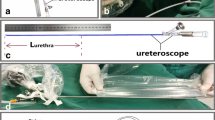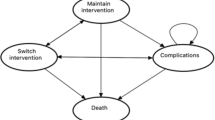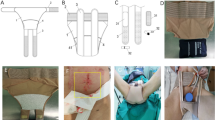Abstract
The purpose of this study was to compare the incidence of urinary infection following sterile catheterisation after either (1) a handwash of 30 s and double gloving, (the shorter sterile technique) or (2) after a 3 minute wash from fingertips to elbows and the wearing of a sterile gown and one pair of gloves, (the longer sterile technique). Forty-six patients were randomly assigned to the two groups. No significant difference in urinary infection rates was found and as a result the more complicated technique has been discontinued
Similar content being viewed by others
Log in or create a free account to read this content
Gain free access to this article, as well as selected content from this journal and more on nature.com
or
References
Larson E . Handwashing: its essential - even when you wear gloves. American Journal of Nursing 1989; 89: 934–939.
Bowell B . Hands up for cleanliness. Nursing Standard 1991; 8 Jan. 6(15/16) pp. 24–5.
Moore K N . Intermittent catheterisation: sterile or clean? Rehabilitation Nursing 1991; 16(–1): 15–18, 33.
McFarlane A . Why do nurses forget to remember handwashing? Professional Nurse 1990; 5: 250–252.
American Operating Room Journal (editorial). Recommended practices: surgical hand scrubs 1990; 52: 830–836.
Maley M P . External handwashing to the forearms. American Journal of Nursing 1989; 11: 1437.
Barnett J . Preventive Procedures. Nursing Times 1991; 6 Mar. 87: 66–8.
Curran E . Protecting with plastic aprons. Nursing Times 1991; Sep. 87(38): 64–8.
Gill J, Slater J . Building barriers against infection. (Use of protective clothing). Journal of Infection Control Nursing Supplement,Nursing Times 1991; 11 Dec. 87 (50): 53–4.
Sanderson P J, Weissler S . The relation of colonization of the perineum to bacteriuria and environmental contamination in spinally injured patients. Journal of Hospital Infection 1990; 15: 229–234.
Guttmann L, Frankel H L . The value of intermittent catheterisation in the early management of traumatic paraplegia and tetraplegia. Paraplegia 1966; 4: 63–82.
Taylor L J . An evaluation of handwashing techniques 1 and 2. Nursing Times 1978; 74: 54 and 74: 108.
Charbonneau-Smith R . No-touch catheterisation and infection rates in a select spinal cord injured population. Rehabilitation Nursing 1993; 18: 5.
Donovan W H, Stolor W C, Clowers D E, Clowers M R . Bacteriuria during intermittent catheterisation following spinal cord injury. Archives of Physical Medicine and Rehabilitation 1978; 59: 351–357.
Anderson, R U Non-sterile intermittent catheterisation with antibiotic prophylaxis in the acute spinal cord injured male patient. Journal of Urology 1980; 124: 392–393.
King R B, Carlson C, Mervine J, Wu Y, Yarkony G . Clean and sterile catheterisation methods in hospitalized patients with spinal cord injury. Archives of Physical Medicine and Rehabilitation 1992; 73: 798–802.
Maynard F M, Diokno A . Urinary infection and complications during clean intermittent catheterisation following spinal cord injury. Journal of Urology 1984; 132: 943–946.
Korniewicz D M, Laughton D, Butz A, Larson E . Integrity of vinyl and latex procedure gloves. Nursing Research 1989; 38: 144–146.
Author information
Authors and Affiliations
Rights and permissions
About this article
Cite this article
Pickard, W., Grundy, D. A comparison of two methods of sterile urethral catheterisation in spinal cord injured adults. Spinal Cord 34, 30–33 (1996). https://doi.org/10.1038/sc.1996.5
Issue date:
DOI: https://doi.org/10.1038/sc.1996.5



